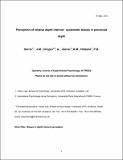Perception of relative depth interval : Systematic biases in perceived depth
Abstract
Given an estimate of the binocular disparity between a pair of points and an estimate of the viewing distance, or knowledge of eye position, it should be possible to obtain an estimate of their depth separation. Here we show that, when points are arranged in different vertical geometric configurations across two intervals, many observers find this task difficult. Those who can do the task tend to perceive the depth interval in one configuration as very different from depth in the other configuration. We explore two plausible explanations for this effect. The first is the tilt of the empirical vertical horopter: Points perceived along an apparently vertical line correspond to a physical line of points tilted backwards in space. Second, the eyes can rotate in response to a particular stimulus. Without compensation for this rotation, biases in depth perception would result. We measured cyclovergence indirectly, using a standard psychophysical task, while observers viewed our depth configuration. Biases predicted from error due either to cyclovergence or to the tilted vertical horopter were not consistent with the depth configuration results. Our data suggest that, even for the simplest scenes, we do not have ready access to metric depth from binocular disparity.
Citation
Harris , J , Chopin , A , Zeiner , K M & Hibbard , P B 2012 , ' Perception of relative depth interval : Systematic biases in perceived depth ' , The Quarterly Journal of Experimental Psychology , vol. 65 , no. 1 , pp. 73-91 . https://doi.org/10.1080/17470218.2011.589520
Publication
The Quarterly Journal of Experimental Psychology
Status
Peer reviewed
ISSN
1747-0218Type
Journal article
Rights
This is a preprint of an article whose final and definitive form has been published in The Quarterly Journal of Experimental Psychology © 2012, copyright Taylor & Francis and The Experimental Psychology Society. The Quarterly Journal of Experimental Psychology is available online at http://dx.doi.org/10.1080/17470218.2011.589520
Collections
Items in the St Andrews Research Repository are protected by copyright, with all rights reserved, unless otherwise indicated.
Related items
Showing items related by title, author, creator and subject.
-
Depth perception with gaze-contingent depth of field
Mauderer, M.; Conte, S.; Nacenta, M.A.; Vishwanath, D. (ACM, 2014-04-26) - Conference itemBlur in images can create the sensation of depth because it emulates an optical property of the eye; namely, the limited depth of field created by the eye's lens. When the human eye looks at an object, this object appears ... -
Perceived depth of 3D disparity-defined objects : continuous edges confer less apparent depth
Cammack, Philip P. K.; Harris, Julie M. (2014) - Journal item -
Diving and depth use in seals : inferences from telemetry data using regression and random walk movement
Photopoulou, Theoni (University of St Andrews, 2012) - ThesisThis thesis focuses on methods for using telemetry data to make inferences about the diving behaviour of seals, in terms of their use of depth over time. Three species are considered: grey seals (Halichoerus grypus) and ...

